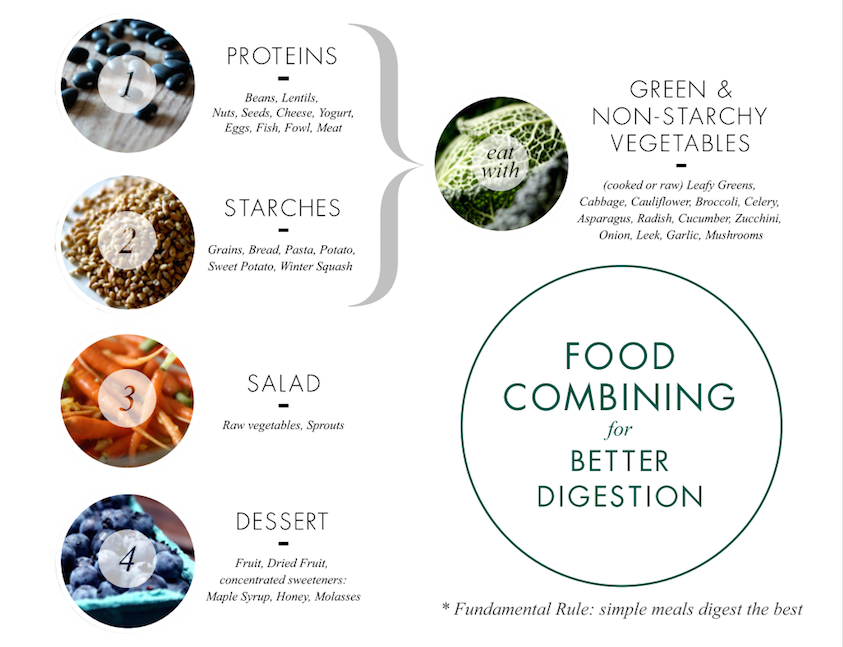
16 Apr Food Combining, All You Ever Wanted To Know!
You asked for it. I just hope you really want to know.
I haven’t posted anything about food combining before for a couple reasons, the first and most glaring excuse being that I don’t strictly follow these rules myself. The second reason is because my goal here is to get you excited about whole food eating, which I feel is such a huge step in the right direction, that throwing another caveat into your new, healthy lifestyle feels cruel. Just when you thought you had it all figured out, here comes another rule?!? I know. I get it.
Judging by the number inquisitive emails piling up, lots of you want to know about this food combining. So what is it exactly?
Food combining is a centuries-old way of eating for optimal digestion and assimilation of nutrients. Food combining centers around the idea that meals should be kept simple in order to be digested properly by enzymatic action – the natural way our body works to break down food and absorb nutrients. As different foods require their own unique enzymes (even foods in the same basic category, such as wheat and barley), too many different foods in one meal confuse the body and it is not able to produce all of the necessary enzymes simultaneously. This leads to a whole host of digestive issues, starting with belching, heartburn, intestinal gas, abdominal pain and swelling. As benign as these symptoms seem, they are just that: symptoms of a larger problem. If you are experiencing these digestive “upsets” on a regular basis, you should definitely consider food combining. After years of ignoring these signs that your body is delivering, you can begin to experience far more serious problems and irreversible damage.
When food is not digested properly, many issues arise. For one, when we eat too many different foods at one sitting, the body has a difficult time digesting through enzymatic action. Instead bacterial digestion takes over, leading to the aforementioned issues, but also creating poisonous bi-products. Secondly, when undigested food leaves the stomach, small portions can pass through into the intestinal tract, become trapped in crevices, and putrefy, producing toxins. Food that the body cannot utilize wastes energy and overworks the organs, which will eventually lead to organ malfunction. Undigested foods are also perfect breeding grounds for unfriendly bacteria that further cause fermentation to occur. Thirdly, tiny particles can pass into the blood stream, causing allergic reactions. The last reason, and one that definitely motivates me, is that food which we do not digest completely, cannot be broken down into parts that our bodies can assimilate. If I choose to invest extra money in organic foods for the higher nutrient levels, isn’t it in my best interest then to eat in way that actually allows me to unlock those nutrients? I think so!
In North American food culture, we’ve been conditioned to eat a “balanced diet”, yet somehow this term has been misinterpreted to mean a “balanced meal”. We throw all kinds of stuff on one single plate, pour a big glass of milk on the side, with the best intentions – to cover all our nutritional bases. Unfortunately, this doesn’t exactly accomplish what we were aiming for.
If we look to our ancestors, and in fact many cultures around the world, individual foods were eaten alone, or combined with only one or two other foods. Such primitive eating patterns were practiced for thousands of years and are the foundation of our digestive capacities. Simple dietary plans are simply best, especially for anyone with compromised digestion, in a weakened or stressed condition. Eating simply is also a way to preserve vitality and maintain strong digestion into the later years of life.
There are two ways of food combining. The first one I’ll present, Plan A, is the “light” version, and designed for people with normal digestion and without any serious health conditions. The second, Plan B, is one that ideally should be followed by everyone, but especially those with poor digestion and major health problems.
Plan A – Food Combining for Better Digestion This plan for food combining is relatively simple and follows eating in a specific order for satisfactory digestion. This does not mean that all of these categories of foods should be eaten in the same meal; it means that the categories should be eaten in a specific sequence. The best-digested meals are in fact very simple ones, including a maximum of three foods per meal.
- ProteinEat proteins first. Although we’re pretty used to digging in the bread basket before our steaks (or legumes, nuts, seeds…) it is best to eat protein foods first as they require the most digestive enzymes in comparison with those required for plants and starches. When you eat protein-rich foods after starches or other food, your stomach acids will not be sufficient for their digestion. Protein foods can be combined with cooked or raw green and non-starchy vegetables.
- StarchEat starches after protein foods, or omit protein foods altogether and eat only starches. Starches can be combined with cooked or raw green and non-starchy vegetables.
- Salad Eat raw vegetables, salad and sprouts after proteins or starch. These foods contain their own enzymes and digest more rapidly than proteins and starches.
- Dessert Eat sweets last. Desserts include fruits, dried fruits, and any foods containing concentrated sweeteners such as honey, maple syrup, or molasses. Because of their relatively simple carbohydrate structures, sweet foods digest very quickly.
Plan B: The Exceptions
Of course there are exceptions to every rule, so just to confuse inform you further, here are a few more conditions to eat by:
- Foods that are high in fat and protein (cheese, yogurt, kefir, nuts, and oil-bearing seeds) are okay to combine with acidic (sour) fruit. Examples: tahini and lemon dressing, almonds and sour apples, yogurt and strawberries.
- Drink dairy milk alone. When milk from animals is consumed with other foods it tends to curdle, insulating itself from digestive enzymes. Curdled/fermented milk products such as cheese, yogurt, and buttermilk do not cause this problem and can combine well with green vegetables.
- Eat melons alone. Melons digest very rapidly, and will cause any other food with which they are eaten to ferment. Proscuitto and cantaloupe = digestive suicide.
- Celery and lettuce can be eaten with fruits.
- Lemon, lime, and tomato can be eaten with green vegetables.
As I said before, I am not so strict when it comes to food combining. I enjoy eating a banana with my morning grains, I like butternut squash and chickpea soup, and I love raw brownies! You should see my breakfast smoothies: I jam just about anything edible into that blender and whizz it up, without batting an eyelash. Fruits, veggies, nut milk, algae, macha green tea powder, bee pollen, avocado, flax oil, …basically something from every single food group because I still have a hard time wrapping my head around the fact that it won’t digest properly – I’ve been taught for so long to eat as much good stuff as possible! Doesn’t that mean all in one go? Argh. I too struggle with being a more health-conscious individual.
So where does this leave us? Well, I am going to continue on my path with greater awareness of these principles, and use them as a guide whenever possible. I will still drink my green smoothies, but maybe commit to proper food combining at least one meal a day. That feels reasonable for me right now. Start small. I love how I am talking myself through this in front of you.


